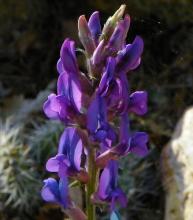This Oxytropis species is found across a vast expanses of North America. There are currently five recognized varieties. Varieties borealis, hudsonica and sulphurea are restricted to boreal enviroments of AK and the Canadan provinces and territories of QC, ON, MB, NT, YT, BC, AB and NU. Variety australis is found at the southern limits of the species range on xeric mountainous environments of the High Sierra Nevada, White and Inyo Mountains of CA, and mountain ranges of south central NV and south central UT.
The widely distributed diverse variety viscida is found across the majority of the ranges mentioned for the other four varieties and transitional forms or subpopulations are often incountered. Variety viscida due to it's huge range is variable in it's physical characteristics.
Flower color can range from white to blue/purple depending upon the varietal standing or local subpopulation profiles.
http://www1.dnr.wa.gov/nhp/refdesk/fguide/pdf/oxyborvis.pdf
http://ucjeps.berkeley.edu/cgi-bin/get_IJM.pl?tid=76688
http://www.calflora.org/cgi-bin/species_query.cgi?where-calrecnum=6035
http://www.calflora.org/cgi-bin/species_query.cgi?where-calrecnum=9174
https://ojs.lib.byu.edu/ojs/index.php/wnan/article/viewFile/219/1327
http://eol.org/pages/2513717/overview
The tufted form I grow seems to fall under the variety viscida umbrella, although I don't feel it is excessivealy sticky to the touch, it is slightly tacky. I find these growing on rocky aluvial fans along the Sierra Nevada foothills. They bloom in shades of pink through blue/purple.
(Moderator: edited PDF link to become live - MMcD)
Comments
Re: Oxytropis borealis
Lori
What a lovely mix of colors in your photos.They are indeed Oxytropis and I agree they appear to be the same species. The population in your photos grows in a more mesic environment than the habitats I find it in.


Great info, John!
I think I see this species (Oxytropis viscida in Flora of Alberta) along the Bow River uplands (http://nargs.org/smf/index.php?topic=694.msg9762#msg9762), although I need to lug the book along sometime and see if I can actually key it out. I collected a tiny bit of seed and grew it this year, so hopefully I will have a captive specimen to study. :)